Back to Silas S. Brown's home page
Solving Micropower Chess (1982)
Jump to shortest solutionI'm only an intermediate player (Elo perhaps 1500 if given enough time), but I did once checkmate some software that "Micro Power" released in 1982 for the then very new BBC Micro Model B (which it ran in screen mode 1)---and as this program always replied to a given sequence of moves in the same way (no random factor), any win against it can be repeated every time and therefore counts as having "weakly solved" that level. I first did this by lasting as long as I could with equal-material exchange, knowing that microcomputers of the time were more likely to play badly in the endgame, but it turns out there are considerably shorter solutions.
Confusion about level numbers
MicroPower released three versions of Chess that ran on the BBC Micro:- a tape version in 1982, with 6 levels numbered 1 through 6;
- a tape "Electron" version in 1983, with levels 1, 3, 5, 7 and 9 identical to the first 5 levels of the 1982 version, plus new
'in-between' levels that introduced randomness; - a BBC Micro disk version (which is what my school had)---this is the 6-level 1982 version plus a relocation loop, but they confused us by adding a loader that explains how level-numbering works on the Electron version (oops!) leading us to believe the highest level was 9 when it wasn't.
&1DF2 (or &2DF2 before relocation)---if the key pressed does not fall between digits 1 and 6, it just sets it to 2 without saying anything.
So if you read the loader instructions as I did, you'll think "best play" is Level 9, but when you choose Level 9 you will get Level 2 (equivalent to Level 3 on the Electron version).
Long solution to Level 2
This was my first solution, in 89 moves (I could have checkmated on move 47 but then we wouldn't have seen an empty-board endgame); the computer made striking mistakes on moves 45, 67 and 76. The program was set to control the Black pieces, and I thought I was playing "Level 9" as I didn't know about the above level-numbering mix-up. (On the other hand, the real best-play levels are so slow they make only a few moves per day, and I doubt anyone would have let me run a computer for long enough to reach an endgame at that speed.)Moves with discussion and screenshots
- e2e4 e7e5 These notes use the simplified algebraic notation that the BBC Micro Chess program accepts as move input. If you make a mistake, there is a one-move take-back facility---press Delete after the computer's reply---but it does have bugs (it doesn't decrement the move number, and strange things happen on move 1 as described below). Or you can start again and supply the same moves until the part you want to change (you can type up to 7 moves into the BBC's 31-keystroke buffer while it's processing). The program has a one-move "opening book": it immediately responds e5 if white first moves the a, c or e pawn, or d5 if white makes any other move, and it opens with e4 if itself playing white (the Electron version can also open with d4). There is a bug if you press Delete at this point: as white, you can repeat your move and not get the opening-book response (it'll usually give you a knight's move instead); as black, pressing Delete before making any moves can cause the computer to take back its e4 and let you move first, or cause stranger things to happen if this isn't your first game in the session. But let's accept the e5 and continue:
- g1f3 b8c6
- f1b5 d8f6 I don't usually bother putting a bishop there because black can just chase it around with pawns, but it's supposed to be a good response to the knight (Ruy Lopez opening). The computer responded by getting its queen out a bit early (Frankfort Gunderam Var response)---if this queen move had been played on move 2 it would have been the Greco Defence, which Greco himself in 1620 suggested responding to by putting a bishop on e4, which in our case would mean 4. b5c4 f6g6, 5. e1g1 (O-O) g6e4, 6. c4f7 e8e7 (if the king were to take that bishop instead of moving, the white knight would then be able to fork king and queen), 7. f1e1 (threatening the queen) e4f4, but then we'd run into problems because Greco's 8. e1e5 gets c6xe5---there wasn't a knight on c6 in Greco's version.
- b1c3 a7a6 "putting the question to the bishop"
- b5c4 b7b5 ditto. Now if c4d5, black responds with b5b4 and threatens the c3 knight and it won't be able to go to d5, so let's put the knight on d5, threaten the queen and see where it goes.
- c3d5 f6d6 probably to defend against the d5xc7 check that would have won the rook
- c4b3 g8f6 I thought I might as well save that bishop for later. Black's going in for a knight exchange makes sense so that its queen can become more mobile again; this also threatens to take the pawn on e4 which is not defended---it can do that first and then go back to f6 for the exchange, so I suppose I'd better defend e4 on my next move.
- d2d3 f6d5 starting the knight exchange
- b3d5 f8e7
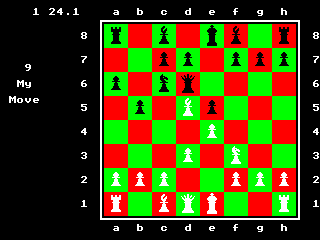 I supposed that taking it with the bishop gives me a slightly more interesting position than taking it with the pawn. The computer then prepared to castle, which makes sense to get out of what my bishop might be threatening.
I supposed that taking it with the bishop gives me a slightly more interesting position than taking it with the pawn. The computer then prepared to castle, which makes sense to get out of what my bishop might be threatening.
- e1g1 e8g8 we might as well both castle
- f3g5 c8b7 I was ganging up on f7, and the computer un-pinned its c6 knight: if it moves now, it'll leave a discovered attack on the bishop and the resulting exchange will leave a pawn undefended
- d1f3 c6d4 I was still thinking about f7. Computer is threatening the exchange and the queen.
- d5f7 g8h8 computer made the only sensible response
- f3h5 h7h6 to avert my threatened checkmate on h7 and to threaten the knight
- g5f3 d4c2 I no longer needed that knight to be on g5 to defend the bishop now the queen has that job; computer picked off a pawn that would have been defended by the queen before the queen was moved out
- a1b1 g7g5 I just moved that rook out of the way of its attack
- c1g5 e7g5 I just thought let's try some more exchanges
- f3g5 h8g7 so we swapped bishops and I'm no longer a pawn down; its h6 pawn is no longer pinned to the king, and now my g5 knight is in trouble and if I move it I won't have enough pieces on f7 to save the bishop
- f7b3 d6d3 to get my bishop out of the way and threaten its knight in exchange for mine; it defended. At this point 20. f1d1 would have won the black queen (there'd be nowhere for it to go), but I wasn't looking for exchanges that ambitious so I didn't see it, and instead played:
- f2f3 d3e3
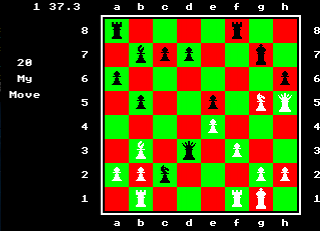 thinking I should defend e4 after my knight was gone. Then it checked me, basically to defend g5 after it takes the knight, otherwise I'd be able to take its g5 and e5 pawns while calling check, which it presumably values more than its knight on c2
thinking I should defend e4 after my knight was gone. Then it checked me, basically to defend g5 after it takes the knight, otherwise I'd be able to take its g5 and e5 pawns while calling check, which it presumably values more than its knight on c2
- g1h1 h6g5 took the knight as I thought
- b3c2 e3d2 I might as well complete the exchange. Computer threatened the bishop again.
- b1c1 f8h8 I might as well defend the bishop. Computer then threatened the queen.
- h5g4 a8f8 I'm not sure what that rook move was supposed to prevent. I left my h2 pawn in potential trouble, but at least I'm defending g2.
- c2b3 b7c6 I was leaving b2 vulnerable but covering the g8 area might be more useful. This computer response was presumably to put another defending piece on d7 to free up the black queen to take my newly-vulnerable b2; this also means advancing its a6 pawn to a4 would trap the bishop on the entire diagonal; if a2a4 then b5a4 b3a4 c6a4 loses a pawn.
- b3d5 c6d5
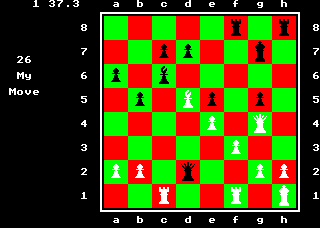 if I'm going to have an exchange that leaves me a pawn down, I'd rather have this one as it might leave a slightly better position
if I'm going to have an exchange that leaves me a pawn down, I'd rather have this one as it might leave a slightly better position
- e4d5 d7d6 I was expecting its queen to take the undefended pawn on d5; it must have evaluated its queen being more useful where it was
- g4e6 f8f7 to stop the white queen from doing too much damage in that corner (white's move can be done seeing as black's D pawn has advanced)
- c1b1 d2f4 I was just defending. Computer threatens mate on h2.
- h1g1 f4h2 it checks anyway just to get a pawn, leaves me only one legal move to make
- g1f2 h2h4 another check: could be perpetual if I went back to g1; playing g3 would lose the pawn after h2+
- f2e3 h4d4 check, leaves only one escape square
- e3e2 d4c4 again this is danger of perpetual check
- e2d2 f7f6 threatening the queen
- e6e7 g7g6 my check was basically just to remove the queen from immediate danger
- d2e3 f6f8
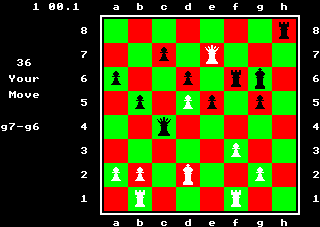 My a2 and d5 pawns were forked and there's not a lot I could do about it, but at least this meant Qxe5 wouldn't be a check and I'd be able to respond by taking c7. I'm not sure why it responded as it did.
My a2 and d5 pawns were forked and there's not a lot I could do about it, but at least this meant Qxe5 wouldn't be a check and I'd be able to respond by taking c7. I'm not sure why it responded as it did.
- a2a3 f8e8 There wasn't much hope for my a pawn, but I could take it out of the immediate line of fire. Computer responded by attacking the queen, but easily sidestepped:
- e7d7 c4d4 (check, left me with only one legal move)
- e3e2 d4c4 (are we going back to perpetual check?)
- e2e3 c4d4 (yes it seems so)
- e3e2 d4c4 (I don't think the program implements any penalty for repetition, so I'd better be the one to do something else)
- e2f2 c4c5 What's the point of checking there? It could be a 'horizon effect'---filling up the search tree with checks pushes back negative outcomes to beyond the number of moves being looked at.
- f2g3 b5b4 it's a pawn up so it can afford the exchange
- f1c1 c5d5 I played a "waiting move", albeit one forcing the queen to do something
- c1c7 d5d3
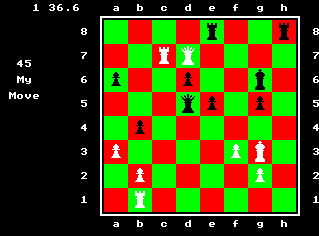 My 2 rooks on the first rank had been very useful up until now, but I'd rather have 2 pieces down the far end of the board for more checks etc. Computer responded by threatening the other rook now that I've moved one of them away, and also attacking the a3 square so it can open that file after exchanging its b pawn. This was a mistake on its part, because it gave me a mate in two (which I missed: I played the Qf7+ correctly on move 46 but then didn't do the Rh1#); it could have averted this checkmate by leaving its queen where it was, perhaps playing Reg8 to also prevent Qg7+ Kf5 Rf7+ QxR QxQ# (or Ke6 Qf6#).
My 2 rooks on the first rank had been very useful up until now, but I'd rather have 2 pieces down the far end of the board for more checks etc. Computer responded by threatening the other rook now that I've moved one of them away, and also attacking the a3 square so it can open that file after exchanging its b pawn. This was a mistake on its part, because it gave me a mate in two (which I missed: I played the Qf7+ correctly on move 46 but then didn't do the Rh1#); it could have averted this checkmate by leaving its queen where it was, perhaps playing Reg8 to also prevent Qg7+ Kf5 Rf7+ QxR QxQ# (or Ke6 Qf6#).
- d7f7 g6h6 black king is forced to the edge, restricting the mobility of black's h rook. I then had a mate in one (47. b1h1 would be an immediate win), but I didn't notice, so play continued:
- b1c1 g5g4 I just thought I might as well move that rook out of trouble now. Too bad I was thinking too much about the c file to notice where else I could have put it---but on the other hand if I had ended the game at this point we wouldn't have seen the computer's two spectacular endgame mistakes later. Meanwhile, after the computer's g4, if Kxg4 Qd4+ Kf5 then one of the two black rooks could attack the queen while pinning it against the king, so I didn't do that, but again I missed the quick win with the white rook (Qg7+ Kh5 Rh1#) and instead played:
- g3h4 d3g6 to parry my threat of Qg7# by offering a queen exchange; I'm a pawn down but I suppose I can still take it as I'll win the pawn on g4 afterwards
- f7g6 h6g6 discovered check from the rook
- h4g4 b4a3 it's exchanging those pawns also, but won't be able to unblock the a file as easily as it could when its queen was on the board
- b2a3 e8d8 now aiming to protect its d and e pawns?
- f3f4 e5f4 it still exchanges that one
- g4f4 d8f8 I'm not entirely sure why it's checking there
- f4e4 f8f2 obviously it values taking that pawn...
- c1c2 f2c2 ...but when I offered a rook exchange instead, it accepted
- c7c2 h8e8 again a check that's buying it time?
- e4d5 e8e3 looks like it's given up on its d pawn and wants to clear the way for the a pawn
- d5d6 e3d3
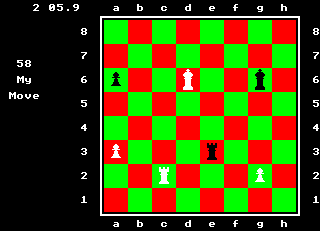 check? why not just get on with taking a3?
check? why not just get on with taking a3?
- d6c5 d3a3 Thought so. Modern 6-piece endgame tablebases say this position is drawn with perfect play on both sides, but we didn't have those when I played this game. We do indeed draw if I play 60. g2g4, because play continues ...g6g5 61. c2c4 (defending) a3g3 (taking it and exchanging rooks would leave it with a king-and-pawn endgame, but the white king is positioned to easily capture the pawn resulting in a draw) 62. c4a4 a6a5 (for what it's worth?) 63. c5b5 g3g4 64. a4a5 leaving king and rook versus king and rook, which is a theoretical draw, and although early microcomputer Chess programs were known for being poor at endgames until tablebases came along, MicroPower is easily able to keep up this draw, in some cases forcing exchange of rooks leaving two lone kings (e.g. 64 ...g4h4 65. b5c6 g5f6 66. a5a6 h4h5 67. c6d7 f6g7 68. a6a7 h5h6 69. d7e8 g7g8 70. a7e7 h6h5 71. e7f7 h5h6 72. e8e7 h6h7 73. f7h7 g8h7)---it's not programmed to declare the draw even then; it'll just carry on moving its king around the board indefinitely. Or you can keep the rooks on the board and do 70. e8d8 h6h5 71. a7e7 g8f8 72. e7d7 h5h6 73. d8c8 f8e8 74. d7c7 h6b6 75. c7a7 b6e6 76. c8b8 e6e7 77. a7a1 e8f7 78. a1f1 f7g6 79. f1g1 g6f5 80. b8c8 f5f6 81. c8d8 e7g7 82. g1f1 f6e5 83. f1f8 e5d6 84. f8f6 d6e5 85. f6h6 e5d4 86. h6d6 d4c5 87. d6a6 c5b5 88. a6a1 b5c6 89. d8e8 g7h7 and so on ad nauseam.
- c5b6 a3a4
- g2g3 a4a3
- c2g2 g6g7
- g3g4 a3a4
- g2g1 g7f6 why? I'd just played a "waiting move" but I wasn't expecting that
- g4g5 f6g6 blocking
- g1g3 a4a2 looks like we both played "waiting moves"
- g3g4 g6f5 attacking the rook. This is a mistake, as I can sacrifice that rook for a guaranteed promotion. Modern tablebases agree: after this move, the result of perfect play changes from "draw" to "white mates in 36".
- g5g6 f5g4
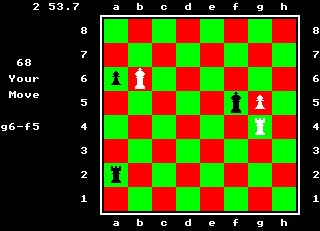
- g6g7 a2b2 check (I thought this was a horizon effect, but modern tablebases say it's actually black's best move and white mates in 34)
- b6a6 b2a2 and modern tablebases say this position is drawn---that taking the pawn was a mistake that turned a "book win" into a "book draw" and I should instead have played Ka7 (playing the tablebases against a BBC emulator gives 70. b6a7 b2b8? 71. a7b8 g4f5 72. g7g8 f5f6 73. g8d5 f6e7 74. b8c7 e7f6 75. c7d7 f6g7 76. d7e6 g7f8 77. d5g5 a6a5 78. g5g6 a5a4 79. g6f7# the poor BBC didn't stand a chance, but I didn't have the tablebases and stupidly did 70. b6a6 instead)---but we'll see it needs a better adversary than the 1982 BBC Micro to obtain a draw from this position. To begin with, the BBC has to keep me in check or I'm going to queen, but it can't do so forever:
- a6b7 a2b2 I covered the a8 square so it can't go up there
- b7c7 b2c2
- c7d7 c2d2
- d7e7 d2e2
- e7f7 e2f2
- f7g6 f2f6 and here we have the BBC's second great mistake of this endgame. A desperate sacrifice of a rook for just a check? It would definitely have been better to save that rook. Did the minimax code ran out of memory or something? Four-piece tablebases agree: this computer's move changes the evaluation from "draw" to "white mates in 9". The most obvious way for it to save the draw would have been f2g2 and g4f3---in either order---there are no two responses I can make to prevent its rook capturing my pawn or queen on the third move of that line; the best I can do is make it an exchange and we end up with two lone kings. Preferring f2f6 to this seems like a search of 3-ply. Its Qd3 mistake on move 45 also suggests a 3-ply search, but it's hard to see how some of its other moves were searched at only 3-ply. Perhaps it has a variable search depth (I'm not sure what would trigger it to search deeper), or it might be fixed at 3-ply but with extra evaluation heuristics to make it seem stronger in certain types of position (but not this one). We'd need some source code to know for sure.
- g6f6 g4f3
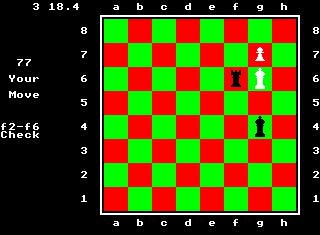
- g7g8 f3e4 It's just as well I wanted a queen, as under-promotions are not supported by this program. Checkmate should be easy now, but I still have to do it. If this program doesn't recognise a king-versus-king draw, I wouldn't expect it to implement any resignation etiquette. Three-piece tablebases say my next play could have been Qd8 to mate in 7, but I was using a simpler heuristic so I called check instead:
- g8g4 e4d5 and the tablebase says I could then have played Qb4 to mate in 5, but I didn't see that, so once again I called check:
- g4e6 d5d4
- e6e5 d4d3 and twice the tablebase figuratively tried to whisper back through time "c5 would have been quicker", but I wasn't listening,
- f6f5 d3c4
- f5e4 c4b3 for once I played a move the tablebase says is best i.e. leads to the fastest mate
- e5d4 b3c2
- d4d3 c2b2
- e4d4 b2c1 and I agreed with the tablebase again (pity about the in-between moves where I didn't)
- d3e2 c1b1
 I had to be careful here: if I had played Kc3 instead of this move, it would have been stalemate. Tablebases agree Qe2 led to the quickest mate from here, in 3 half-moves.
I had to be careful here: if I had played Kc3 instead of this move, it would have been stalemate. Tablebases agree Qe2 led to the quickest mate from here, in 3 half-moves.
- d4c3 b1c1
- e2c2#
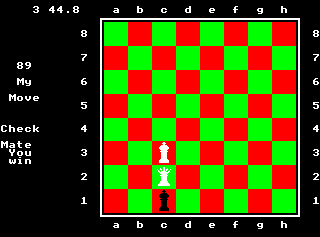
Same game in PGN
1. e4 e5 2. Nf3 Nc6 3. Bb5 Qf6 4. Nc3 a6 5. Bc4 b5 6. Nd5 Qd6 7. Bb3 Nf6 8. d3 Nxd5 9. Bxd5 Be7 10. O-O O-O 11. Ng5 Bb7 12. Qf3 Nd4 13. Bxf7 Kh8 14. Qh5 h6 15. Nf3 Nxc2 16. Rb1 g5 17. Bxg5 Bxg5 18. Nxg5 Kg7 19. Bb3 Qxd3 20. f3 Qe3 21. Kh1 hxg5 22. Bxc2 Qd2 23. Rbc1 Rh8 24. Qg4 Raf8 25. Bb3 Bc6 26. Bd5 Bxd5 27. exd5 d6 28. Qe6 Rf7 29. Rb1 Qf4 30. Kg1 Qxh2 31. Kf2 Qh4 32. Ke3 Qd4 33. Ke2 Qc4 34. Kd2 Rf6 35. Qe7 Kg6 36. Ke3 Rff8 37. a3 Re8 38. Qd7 Qd4 39. Ke2 Qc4 40. Ke3 Qd4 41. Ke2 Qc4 42. Kf2 Qc5 43. Kg3 b4 44. Rfc1 Qxd5 45. Rxc7 Qd3 46. Qf7 Kh6 47. Rbc1 g4 48. Kh4 Qg6 49. Qxg6 Kxg6 50. Kxg4 bxa3 51. bxa3 Rd8 52. f4 exf4 53. Kxf4 Rdf8 54. Ke4 Rf2 55. R1c2 Rxc2 56. Rxc2 Re8 57. Kd5 Re3 58. Kxd6 Rd3 59. Kc5 Rxa3 60. Kb6 Ra4 61. g3 Ra3 62. Rg2 Kg7 63. g4 Ra4 64. Rg1 Kf6 65. g5 Kg6 66. Rg3 Ra2 67. Rg4 Kf5 68. g6 Kxg4 69. g7 Rb2 70. Kxa6 Ra2 71. Kb7 Rb2 72. Kc7 Rc2 73. Kd7 Rd2 74. Ke7 Re2 75. Kf7 Rf2 76. Kg6 Rf6 77. Kxf6 Kf3 78. g8=Q Ke4 79. Qg4 Kd5 80. Qe6 Kd4 81. Qe5 Kd3 82. Kf5 Kc4 83. Ke4 Kb3 84. Qd4 Kc2 85. Qd3 Kb2 86. Kd4 Kc1 87. Qe2 Kb1 88. Kc3 Kc1 89. Qc2#In more modern times I tried a similar technique on Magnus Carlsen's 2014 iOS app and narrowly beat "age 10" (which is different from Magnus's real age 10: Tord Romstad set progress more 'linear' when tuning his Stockfish predecessor for the app)---it let me win an otherwise-drawn endgame by responding to move 78 inaccurately. These games are not usually reproducible as the engine adds a random factor, but here it is for reference:
Moves as PGN
1. e4 c6 2. Nf3 d5 3. Bd3 dxe4 4. Bxe4 Nf6 5. Nc3 b5 6. Bd3 g6 7. O-O a5 8. Re1
Bg7 9. a4 b4 10. Ne4 Nd5 11. c3 f5 12. Nc5 Qd6 13. Nb3 O-O 14. c4 Nf4 15. Bc2
Nd3 16. Bxd3 Qxd3 17. c5 f4 18. Ne5 Bxe5 19. Rxe5 Re8 20. Qf3 Qxf3 21. gxf3 h6
22. d4 g5 23. Bd2 Kf7 24. Kg2 Ra7 25. Rae1 e6 26. Rd1 Rh8 27. Rde1 Kg8 28. Rd1
Kf7 29. Rde1 Rg8 30. Rd1 Nd7 31. Re4 h5 32. h3 Nf6 33. Re5 Nd7 34. Re4 Ra8 35.
Rde1 Nf6 36. Re5 Nd5 37. Rd1 Ra7 38. Rde1 Rg6 39. Rd1 Bd7 40. Rde1 Ra8 41. h4
Kf6 42. hxg5+ Rxg5+ 43. Rxg5 Kxg5 44. Re5+ Kh6 45. Kh3 Kg6 46. Kh4 Ne7 47.
Bxf4 Nf5+ 48. Kh3 Bc8 49. Nd2 Kf7 50. Ne4 Nxd4 51. Nd6+ Kg7 52. Nxc8 Rxc8 53.
Rxh5 Nf5 54. Rg5+ Kf6 55. Kg2 Ra8 56. Kf1 Nd4 57. Kg2 Rh8 58. Kg3 Ne2+ 59. Kg4
Nxf4 60. Kxf4 Rh1 61. Rg8 Rh4+ 62. Ke3 Rc4 63. f4 Rxc5 64. Rc8 Rc2 65. b3 Rc1
66. Ke4 Rc3 67. Rf8+ Ke7 68. Rc8 Rxb3 69. Rxc6 Rb1 70. Ra6 Ra1 71. Rxa5 Ra2
72. f3 Kf7 73. Kd3 Kf6 74. Kc4 Ra3 75. Kxb4 Rxf3 76. Rc5 Rxf4+ 77. Kb5 Rf2 78.
a5 Kg7 79. a6 Rb2+ 80. Ka5 Kf6 81. a7 Ra2+ 82. Kb6 Rxa7 83. Kxa7 Kg7 84. Re5
Kf7 85. Kb6 Kf6 86. Re1 Ke7 87. Kc5 Kd7 88. Kd4 Kd6 89. Ke4 Kc5 90. Ke5 Kc6
91. Kxe6 Kc5 92. Rd1 Kb4 93. Kd5 Kb3 94. Rc1 Ka3 95. Kc4 Kb2 96. Rc3 Ka1 97.
Kb3 Kb1 98. Rc2 Ka1 99. Rc1# 1-0
Fishing-Pole Trap
In the BBC Micro days I had no way of knowing about Brian Wall's "fishing-pole trap" operated by black (open with knights and sacrifice one on g4 to expose white's castled king)---I don't think it was published before the 21st century (unless someone discovered it independently). Experimenting on an emulator shows the BBC Micro's Level 2 is vulnerable to this trap and it reduces the game length to 14 moves, which is rather fewer than I originally took:1. e4 e5 2. Nc3 Nf6 3. Nf3 Nc6 4. Bc4 Bc5 5. O-O Ng4? (setting the trap) 6. Na4 Bd6 7. h3 h5? 8. hxg4?? (falling for the trap) hxg4 9. Nh2?? (falling much further in) Qh4 10. Bxf7+ Kxf7 11. f3? g3 12. Re1 Qxh2+ 13. Kf1 Nd4 14. c3 Qh1#This also works on the Electron version's Level 3 if it starts with e4 not d4. It does not work on higher levels.
Using modern engines
The shortest game I found against an unassisted modern engine was 16 moves, with MicroPower level 2 controlling the white pieces against 2002's Sjeng 11 (the engine behind Apple Chess) in a mid-level mode:Moves
1. e4 e5 2. Nc3 Nf6 3. Nf3 Nc6 4. Bc4 Bc5 5. O-O d6 6. Ng5 O-O 7. Nxf7 Rxf7 8. Bxf7 Kxf7 9. Qe1 Nd4 10. Qd1 (?) Bg4 11. f3 Nxf3+ 12. Kh1 Nxh2 13. Rxf6+ (??) Qxf6 14. Qe1 Nf3 15. gxf3 Qxf3+ 16. Kh2 Qh3#I was able to reduce this to 14 moves as white by manually playing an unusual opening until the computer put its king in a risky place (misfired heuristic?), then letting a modern engine "do the honours" from move 8:
1. g3 d5 2. Bh3 Be6 3. Bxe6 fxe6 4. Nf3 Nc6 5. O-O Nf6 6. d4 Kf7? 7. Ng5+ Kg6? 8. Qd3+ Ne4 9. h4 e5 10. h5+ Kxh5 11. Qf3+ Kg6 12. Qf7+ Kh6 13. Nxe4+ g5 14. Bxg5#and then a couple of manual experiments shortened this still further, to a 12-move game that (oddly enough) gives discovered checkmate by 'pawn to king 4':
1. g2g3 d7d5 2. f1h3 c8e6 3. h3e6 f7e6 4. g1f3 b8c6 5. h1g1 g8f6 6. d2d4 e8f7 7. f3g5+ f7g6 8. h2h4 d8c8 9. h4h5+ g6h5 10. g3g4+ h5h4 11. g1h1+ h4g4 12. e2e4#
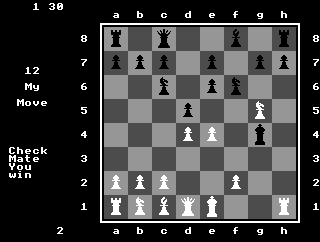 This works on Level 2, but meets a different response on Level 1 that requires another half-dozen moves to win.
This works on Level 2, but meets a different response on Level 1 that requires another half-dozen moves to win.
If the exact algorithm is known for a deterministic weaker engine then I suppose a stronger engine could be "tuned" to win faster by laying 'traps'---non-best moves that result in this particular opponent making an even bigger mistake---by modifying the minimax algorithm in the stronger engine to prune out lines the weaker engine wouldn't choose (e.g. never mind "10. g4 is not as good as Qd3 because the black king could go back to g6 and escape our forced mate in 4" if we know it'll actually go to h4 and we mate in 3). This would probably amount to emulating the weaker engine (with its different static evaluator and search depth) at every candidate 'opponent to move' position instead of doing alpha-beta pruning (because alpha-beta pruning is not applicable to trees where there's only ever one opponent move), but you might want to limit this "trap pruning" to upper levels of the tree (probably down to at most the difference between the two engines' ply depths), and there'll be places where the simulation of the weak engine can be optimised.
Higher levels
Now we know I was actually playing Level 2 (not 9), I suppose for completeness I should also post solutions to the actual higher levels (I took some hints from modern engines to save time).Moves
- Level 3 (Electron level 5)
- 1. e2e4 e7e5, 2. d2d4 d8f6, 3. d4e5 f8b4+, 4. c2c3 f6e5, 5. c3b4 e5e4+, 6. d1e2 e4e2+, 7. f1e2 b8c6, 8. a2a3 g8f6, 9. g1f3 O-O, 10. e1g1 f8e8, 11. b1c3 d7d6, 12. c1g5 c8d7, 13. g5f6 g7f6, 14. f1e1 g8g7, 15. e2d3 a8c8, 16. e1e4 e8e4, 17. d3e4 f6f5, 18. e4d5 c8e8, 19. c3b5 e8e2, 20. a1b1 a7a6, 21. b5c7 f5f4, 22. g1f1 e2e7, 23. b1e1 e7e1+, 24. f1e1 g7f6, 25. e1d2 f6g7, 26. f3g5 f7f6, 27. g5e4 c6d4, 28. d5b7 f6f5, 29. e4d6 d4b5, 30. d6b5 a6b5, 31. b7a6 d7c6, 32. f2f3 g7f6, 33. a6b5 c6b5, 34. c7b5 f6e7, 35. b5d4 e7f6, 36. b4b5 f6e5, 37. b5b6 e5d4, 38. b6b7 d4c5, 39. b7b8 c5d5, 40. b8b6 h7h5, 41. b2b3 d5e5, 43. b6c6 h5h4, 43. h2h3 e5d4, 44. c6d6#
- Level 4 (Electron level 7)
- 1. e2e4 e7e5, 2. d2d4 e5d4, 3. c2c3 d8e7, 4. f1d3 b8c6, 5. g1f3 d7d5, 6. e1g1 d5e4, 7. d3e4 d4c3, 8. b1c3 g8f6, 9. e4c6 b7c6, 10. d1a4 a8b8, 11. f1e1 c8e6, 12. f3e5 e7b4, 13. a4c6 e8d8, 14. e5f7 e6f7 (oops I wasn't paying attention, carried on anyway as the game was likely recoverable), 15. e1d1 f8d6, 16. c1g5 h7h6, 17. g5f6 g7f6, 18. c3e4 d8e7, 19. e4d6 c7d6, 20. c6c7 e7f8, 21. d1d6 b4b2, 22. a1d1 f8g7, 23. d6d7 b2a2, 24. c7g2 g7h7, 25. h2h4 h8c8, 26. g3f4 h7g7, 27. d7d3 a2e6(?), 28. d3e3 e6c6, 29. d1d6 c6c1+, 30. g1h2 c1c4, 31. f4f6 g7g8, 32. e3g3 g8f8, 33. d6d7 c4e6, 34. f6h8 f7g8 (still takes time because the engine evaluates every candidate move even when there's only one option), 35. g3g8 e6g8, 36. h8f6 f8e8, 37. f6e7#
- Level 5 (Electron level 9)
- 1. e4 e5 2. Nf3 Nc6 3. Bb5 Nf6 4. O-O Nxe4 5. d4 exd4 6. Re1 f5 7. Nxd4 Bc5 8. Rxe4+ fxe4 9. Qh5+ g6 10. Qxc5 Qe7 11. Qc3 Rf8 12. Bh6 Rf7 13. Bc4 g5 14. Nb5 d5 15. Bxd5 Rb8 16. Qh8+ Kd7 17. Bxf7 Qxf7 18. N1c3 a6 19. Rd1+ Ke6 20. Nxe4 Kf5 21. Nbd6+ cxd6 22. Nxd6+ Kg6 23. Nxf7 Kxf7 24. Rd6 Bf5 25. Qg7+ Ke8 26. Qf8#
- Level 6 (no Electron level)
- First 6 moves same as Level 5, then: 7. Nxd4 Qf6 8. Bxc6 dxc6 9. f3 c5 10. Nb5 Qb6 11. N1c3 c4+ 12. Be3 Qc6 13. fxe4 fxe4 14. Qh5+ Kd8 15. Bg5+ Be7 16. Bxe7+ Kxe7 17. Nd5+ Kf8 18. Rf1+ Qf6 19. Rxf6+ gxf6 20. Qh6+ Kf7 21. Qxf6+ Kg8 22. Ne7#
Default "Replay" game
MicroPower's "Replay" feature normally plays back the last-played game. The limit is 150 moves each (actually it's 303 ply but castling counts as 2½ ply); Replay also has display bugs if you've played 130-odd moves and left the game unfinished.If you choose Replay before any game has been played, it gives you a 41-move sample game that seems incomplete. Moves are stored in RAM at &19A0 (relocated from &29A0, from file CHESS offset BA0, from disk-image offset 1FA0); the first two bytes point to the next free slot, then start and destination squares are encoded as 10*(rank+1)+file where rank and file start at 1; for castling the king's move is coded first and then the rook's after a byte 01.
This turns out to be a copy of Fischer versus Spassky, Reykjavik world championships (Iceland), 7 January 1972 round 6. It's "incomplete" because Spassky resigned after Fischer's 41. Qf4---the computer doesn't tell you this and just returns to the menu. (Modern engines tend to checkmate black within 7 moves, e.g. ...Qg8 42. Qe5 Rh7 43. e7 Qxg2+ 44. Kxg2 Rg7+ 45. Kf3 Kh7 46. Bd3+ Rg6 47. Rxg6 Rc8 48. Rg5#)
MicroPower documented the inclusion of the Fischer-Spassky game on the back cover of the 1982 tape release, but then it was removed for the 1983 "Electron" release (probably because extra code necessitated moving the Replay buffer to &400 which is outside the program's load-address range and they didn't fancy writing a relocator), and when they later brought back the 1982 version for a disk release they apparently forgot it included a Fischer-Spassky game and didn't mention it, making it a so-called "easter egg". (At school I assumed it to be a pre-generated computer self-play and wondered why I could never get the same moves with the Play option.)
Other differences with the Electron version
As already mentioned, the 1983 re-release "for the Acorn Electron" (although the BBC Micro can run either version) changed the level numbers---levels 1, 2, 3, 4 and 5 were renumbered 1, 3, 5, 7 and 9, with randomised intermediate levels added and the old Level 6 dropped---and the bundled copy of the Fischer-Spassky game was removed.Other changes were:
- The Electron version does not use the keyboard buffer, so when playing a deterministic level you cannot enter moves ahead of the computer as you can with the BBC Micro version. This is somewhat made up for by the added ability to continue from any point in a replay.
- Support for under-promotion is added (the computer asks "Piece?" when you promote) although only queen promotions are included in the search.
To demonstrate this without waiting for the computer too long, here's a 42-move win against Level 1 that includes two promotions, behaving identically on both versions.
Moves
1. e4 e5 2. d4 Nc6 3. d5 Nd4 4. c4 Nf6 5. Nc3 Bd6 6. f3 O-O 7. Ng1-e2 c5 8. Nb5 Qd6 9. Ne2xd4 cxd4 10. Bd3 a6 11. Nxd6 Qxd6 12. a4 Re8 13. O-O a5 14. Bd2 Qb6 15. b4 axb4 16. Rb1 b3 17. Rxb3 Qc5 18. Rb5 Qa3 19. Bc2 d3 20. Bb3 Qd6 21. c5 Qc7 22. d6 Qc6 23. Re1 Ra6 24. Bg5 d2 25. Re2 h6 26. Bxf6 gxf6 27. Bd5 Qxb5 28. axb5 Ra1 (ah yes, I let it keep a pawn on d2 to get a 3-ply mistake like this) 29. Qxa1 Kg7 30. c6 bxc6 31. Bd5xc6 dxc6 32. bxc6 Be6 33. c7 Bc4 34. Rxd2 h5 35. d7 Rh8 36. d8=Q Rxd8 37. cxd8=Q Be6 38. Qa1-a8 h4 39. g4 Bc4 40. g5 fxg5 41. Qxg5+ Kh7 42. Qa8-g8# - When the computer controls the white pieces, instead of always opening with e4, it now chooses at random between d4 and e4 (even on the odd-numbered levels that don't otherwise involve randomness). The opening behaviour when you play white is unchanged (e5 if you first move from a, c or e, d5 otherwise).
- The menu has fancier formatting, clocks are displayed for both players (not just the user), the "Replay" option prints a scrolling list of moves beside the board and you can continue from any point or save/load the moves, move 'animations' are slightly faster (with a slightly longer beep for "illegal move") and colours are customisable.
The bugs associated with the Delete key are still present.
Tube compatibility and other Chess software
The only Chess engine reviewed by Beebug was Martin Bryant's Colossus in 1987 (plays at 12-ply with estimated 1850 Elo if given enough time, and has a monochrome Mode 4 display); this outperformed earlier engines but fewer schools had the disk. Colossus does not always make the same moves, so you won't be able to "solve" a level with a single win as you can with MicroPower.Tube compatibility is relevant if you have a "PiTubeDirect" ~140× speed second processor instead of a BBC emulator running at ~15× speed---although both options are now outpaced by Chris Evans' "BeebJIT" which can achieve 5000+× speed on AMD64 (and has a mode to do so while keeping timers at normal speed, so you don't have to toggle back to 1× to type as you do with older emulators).
MicroPower Chess is basically Tube-compatible but the chessboard is invisible: you see only the coordinates. Colossus however has more serious Tube problems. Acornsoft Chess (which Arthur Norman helped write) and Computer Concepts Chess (and its Superior re-release, both by David Thompson) have full Tube compatibility and don't always make the same moves, while Bug-Byte Chess is fully Tube compatible and deterministic (although slow to update the screen)---but it's less clear what counts as "solving" it as its search parameters may be configured in hundreds of ways (albeit none of them strong by modern standards)---however these programs all use low-resolution Mode 5 pieces that can be hard to tell apart, meaning that, in order to avoid making blunders due to misidentifying an opponent piece, you either have to get used to their odd pixel art or else keep track of the position separately, meaning there's little advantage over MicroPower's invisible board; perhaps the lack of Mode 1 graphics contributed to these programs' being less popular with schools than MicroPower's.
Copyright and Trademarks
All material © Silas S. Brown unless otherwise stated.Apple is a trademark of Apple Inc.
Any other trademarks I mentioned without realising are trademarks of their respective holders.